Syngenta buys Floranova
Explaining that it will serve to enhance their presence in emerging markets, Syngenta Flowers has announced that it is buying UK flower breeder Floranova, a respected flower and home garden vegetable seed breeder with a broad portfolio and customers in more than 50 countries.
Floranova, based in Foxley, Norfolk, England, about 130 miles northeast of London, will continue to operate as an independent company.
Michael Kester, Head of Flowers, Syngenta, said in a press release that “Floranova’s complementary seeds offer covers some important gaps in Syngenta’s portfolio and brings flower seed crops like pelargonium, petunia, begonia and a distinctive product line of patio vegetables.” (The deal includes Floranova’s Vegetalis vegetable seed division.)
Founded in 1978 by breeder Mike Hough, and for a while owned by Lord Sainsbury of the Sainsbury’s supermarket chain, Floranova’s broad portfolio and international presence will be important in fast-growing markets, such as China and India, says the release. In 2017, Floranova generated high single digit million USD sales with a broad customer base ranging from the U.S. and Europe to the Middle East and Asia.
“Our intent is to maintain and leverage the Floranova brand in a dual brand concept,” Michael says. “Both Syngenta and Floranova will continue to operate as independent companies, with their own distribution and differentiated portfolio. This provides exciting new opportunities to strengthen our overall presence in the global flowers market,” he added.
Jeff Colegrave, the outgoing Chairman of Floranova, has owned the business since 2005. His father, David, started Colegrave Seeds in 1962. Jeff took over Colegrave after David’s death in 1992. He sold the business to Ball Horticultural Company in 2001.
Said Jeff of the sale, “I am proud of the achievements of Floranova during the period of my ownership; there has been exciting development and growth, particularly in the Asian markets. The acquisition of Floranova by Syngenta is excellent news for all stakeholders and will mean Floranova will be stronger and better placed to face the challenges in a highly competitive marketplace.”

Color Spot Finds a Buyer (two, actually)
In a bankruptcy auction held July 18-20, Color Spot Nurseries got a new owner: Wells Fargo Bank … which also happened to be Color Spot’s biggest creditor. Wells Fargo took over ownership of the business with a successful bid of about $74 million in cash and credit and $9 million in working capital to keep the business operating.
Operating for how long? They hope it won’t be for long, says a source close to the deal. I was told that Wells Fargo is “actively pursuing … solid leads.” They have already taken advantage of one of those, spinning off three locations in California and Oregon—former Hines locations—to TreeTown USA, which had put in an unsuccessful bid of $10 million for those assets. TreeTown CEO Jonathan Saperstein told me that Wells Fargo contacted them after the auction, offering up that portion of the business. Several other prominent names in the California and Texas markets were mentioned as expressing interest, but none have been confirmed, so I won’t name them here.
My sources tells me that Wells Fargo will continue operating the business even as they seek interested and qualified buyers; the $9 million in operating capital that they put up speaks to their willingness to give it some time. Which is key, since keeping customers confident and buying could be important to maintaining the value of the assets.

Jonathan Saperstein on not going the way of Hines and Spot
While I was talking to Jonathan about his purchase of the Hines portion of Color Spot, I asked him how, as TreeTown gets larger and more far-flung from its Texas home, he avoids suffering the same fate as the business he is now buying out of bankruptcy.
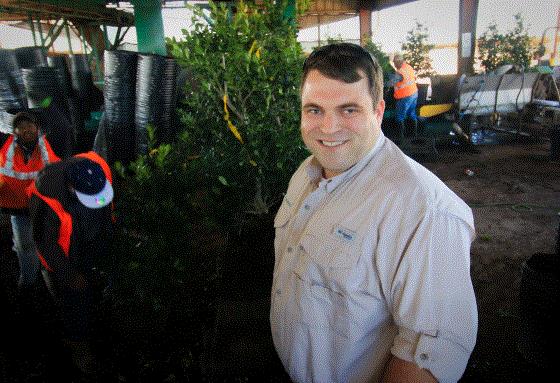
“The biggest thing is making sure we have a solid future plan—that our strategy is something that everyone believes in,” he replied. “The next part is to have a diversified business; we want to make sure we are financially strong enough to weather any storms. And taking the things those companies did well—which is a lot of things—and incorporating those to make our company better. Get rid of the bad and take only the good parts.”
TreeTown has weathered storms—last year his business was hit by hurricanes in both Texas and Florida.
“This year, in that division, the facilities that got hit are still having record months. That whole division is performing very well even though they got hammered by storms and we had inventory losses that we can’t quickly make up for.
“If [the hurricanes] hadn’t have happened, imagine how good it would have been!”

In Pennsylvania
Last week, I spent a couple days in bucolic Lancaster County, Pennsylvania, to speak at the Penn State Field Trials at the University’s Manheim research facility. I arrived in Harrisburg to find that about a dozen inches of rain had fallen in the past week, washing out roads and bridges and even threatening access to the trial grounds. Luckily, I brought the sunshine with me, as always, and the rivers had dropped enough to allow life to return to normal and trial attendees to walk the rows without getting soaked. It certainly gave the plants a good test of weather-resistance!
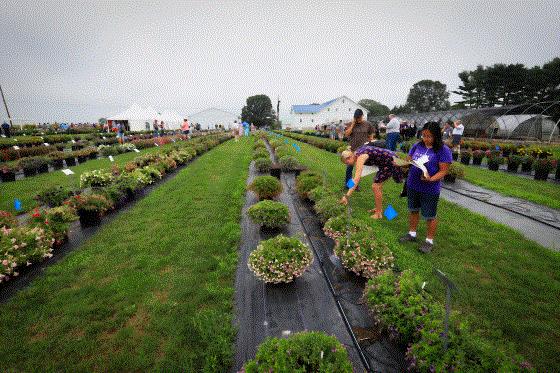
Extension educator Sinclair Adam has been in charge since 2013; there’s been a trial in Manheim since the late ’80s. The Penn State Flower Trials are 85 years old this year (the same age as the Ball trial grounds!). About 220 folks throughout the state and as far away as Ohio and New England came. Quite a few of the local Amish growers were also present, including those who came by traditional horse and buggy. (They got the best parking spots.)
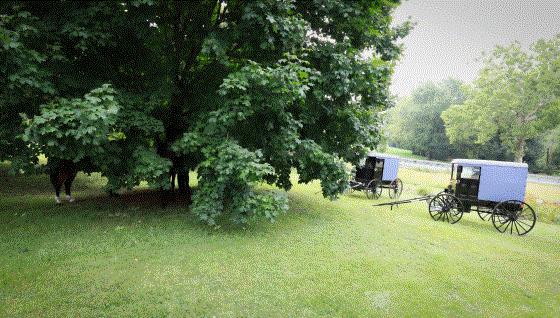
It’s a good-size trial: On display were 1,000 varieties of annuals and perennials, give or take (some perennials didn’t make it through the roller coaster winter temperatures, for instance), supplied by 30 participating breeders. Newcomers to the trials including AmeriSeed, Cohen and The Primrose Path, a small Pennsylvania breeder of perennials, namely tiarella and heuchera (Tiarella Elizabeth Oliver and Heuchera Stainless Steel are two of their well-known varieties).
A small vendor area featured sponsors such as Raker-Roberta’s, Lucas Nursery, Gary’s Specialty Plants, Skagit Gardens, Gro & Sell, and Emerald Coast Growers and Aris Greenleaf (the latter two whom I visited the day before). I was impressed to learn that Gary Hunter of Gary's Specialty Plants was moving loads of small foliage plants and hanging baskets to area retailers. He got into houseplants from annuals about 8 years ago and now moves a ton of them. He even had the current "it" plant, Pilea peperomioides, in 2.5-inch pots.
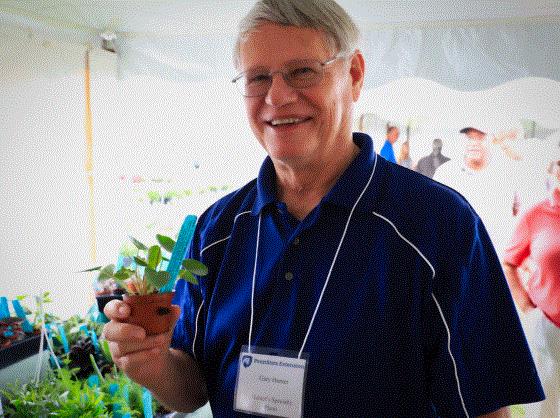
One interesting on-going trial at the site is a study of whether or not pollinators are more or less attracted to specific cultivars. This is the second year of the study. Last year, it was annuals in pots. This year, it’s perennials. No data has been released yet—“She’s careful,” Sinclair says of Emelie Erickson, the grad student doing the research. “She doesn’t want to let the cat out of the bag until all the data is in.”
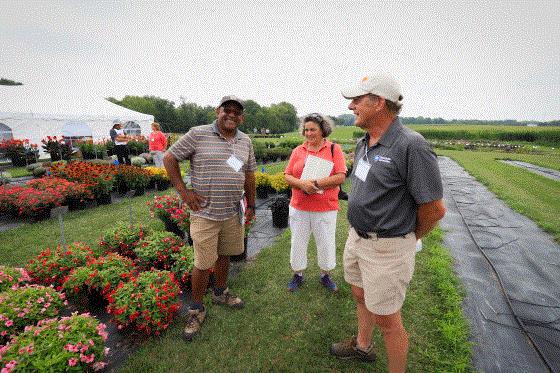 Sinclair (right) with local retail growers Marc and Leonie Brooks of Brooks Coventry Plants.
Sinclair (right) with local retail growers Marc and Leonie Brooks of Brooks Coventry Plants.
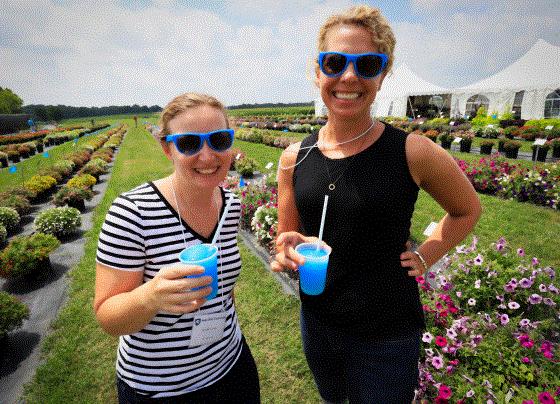 Krystal Snyder and Cari Peters of J.R. Peters in Allentown, Pennsylvania, enjoying a frozen treat in the same color as their Jack’s Classic fertilizer.
Krystal Snyder and Cari Peters of J.R. Peters in Allentown, Pennsylvania, enjoying a frozen treat in the same color as their Jack’s Classic fertilizer.

Ball Customer Day
Another trial garden celebrating 85 years is that of Ball Horticultural Company, which has been trialing varieties at its West Chicago, Illinois, home since 1933. Back then, it was row trials; today, it’s rows … and swooping beds and pots and baskets and annuals and perennials and vegetables and shrubs and even the latest greenhouse automation. I made it back from Pennsylvania in time to help welcome the 1,200-plus visitors to the big day of the year for Ball, always held the last Friday in July. The weather couldn’t have been more perfect; all the rain was in Pennsylvania and all the heat was in Arizona.
 Snoopy the drone captured the festivities from above.
Snoopy the drone captured the festivities from above.
Jen Zurko and I shot a video tour of the day, complete with interviews with Anna Ball and representatives from all the Ball divisions, including PanAmerican Seed, Ball FloraPlant, Star Roses & Plants and Ball Ingenuity. I’ll have it posted to YouTube by the next Acres Online.
Children of all ages now welcome at IGC Chicago
Recognizing that this is a family industry, and sometimes young kids want to be included in the business activities with mom and dad, IGC Show founders Jeff and Cheryl Morey have dropped their long-time policy of restricting those under 14 years old from attending the show. Now you can bring the entire family, from infants on up, to the event, slated for August 14-16 at Chicago’s Navy Pier.
Why the change of policy? A change of heart.
“We were already poised to change the age-restriction policy next year at IGC Show 2019,” says Jeff. “Then, this past week, we received a call from a mother of a family garden center in Ohio who was eager to attend the IGC Show for the first time. When she learned that her 12-year-old son, who works in-season as a cashier at her store, would be prohibited by the show’s age restrictions, she was deeply disappointed.
“It pulled at my heartstrings, bringing back memories of my own early start in our family business at just six years of age. It was only a few years later that I attended the old AAN convention with my dad.
“While there were reasons for the previous age limits, the time has come to encourage the up-and-coming generations and their children, and to honor the backbone of this wonderful garden center industry—the small, family-run business, where even the youngest pitch in.”
Register yourself and your offspring at IGCShow.com/Register. Use the discount code LAKE for an All Access Pass to Continuing Education @ IGC for just $129, and add additional family members for $101.
As for me, I make no promise that I will act my age while attending.

Houseplants as health monitors?
A plant scientist and an interior designer from the University of Tennessee (and the plant scientist’s wife) have come up with a crazy idea: Can houseplants be bred to warn us of dangers in our environment, like radon or mold?
That’s the idea coming from an article in the July 20 issue of Science. Professor Neal Stewart co-authord the article with his wife, Susan, and Rana Abudayyeh, an assistant professor in the UT College of Architecture and Design’s School of Interior Architecture (Susan was one of Rana’s students).
“Houseplants are ubiquitous in our home environments,” says Professor Stewart. “Through the tools of synthetic biology it’s possible for us to engineer houseplants that can serve as architectural design elements that are both pleasing to our senses and that function as early sensors of environmental agents that could harm our health, like mold, radon gas or high concentrations of volatile organic compounds.”
He explains that plant biosensors could be designed to react to harmful agents in any number of ways, such as gradually changing the color of their foliage or through the use of fluorescence.
Adds Professor Abudayyeh, “Biophlic design builds on our innate affiliation with nature, so integrating biophlic elements within the interior volume carries rich implications spatially and experientially. Building responsive capabilities into interior plants is revolutionary. It allows biophlic elements within space to assume a more integral role in the space, actively contributing to the well-being of the occupant holistically.”
In other words, “They can do a lot more than just sit there and look pretty,” says Professor Stewart. “They could alert us to the presence of hazards in our environment.”
Mind you, it’s just a presentation of the concept. Now somebody has to breed the plants!

Finally I …

Whose pants are they?
Suzanne “Buglady” Wainwright, of course. All but one of you got it right.
Finally II …
Last week, GrowerTalks managing editor Jen Zurko and publisher Paul Black attended the grand opening of Valent BioSciences’ new global research facility, Biorational Research Center in Libertyville, Illinois, north of Chicago, where they’ll be doing all sorts of high-tech research, including entomology.
Apparently, entomologists can bring their pets to work. Like this Madagascar hissing cockroach. Somehow, they convinced bug-averse Jen Z. to hold it. Paul sent me this photo. Later, I asked her how it was.
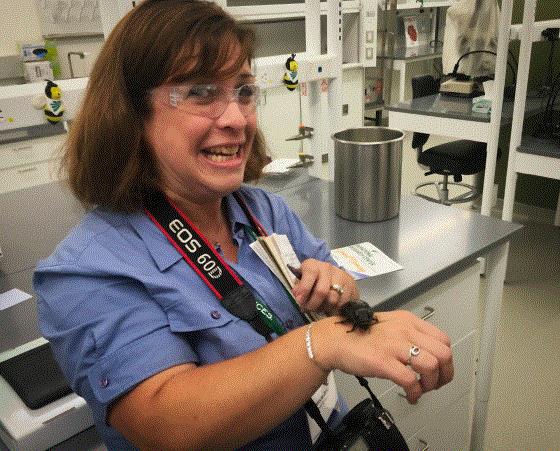
“I was totally [blanking] my pants and sweating the whole time,” she replied in her usual understated way. “You don’t understand how hard that was for me.”
See you next time,

Chris Beytes
Editor
GrowerTalks and Green Profit
This e-mail received by 23,102 loyal readers!
Thanks to my loyal sponsors, who help me reach the 23,102 readers of Acres Online in 66 countries. Want to be one of them (a sponsor, that is)? Give Paul Black a shout and he'll hook you up.